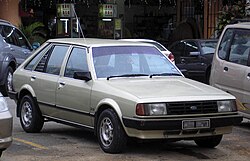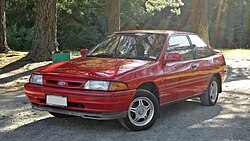Ford Laser
The Ford Laser was a lower middle class car sold by the US car manufacturer Ford from 1980 to 2003, which saw several model generations.
All laser models were based on the Mazda 323 platform . Ford had acquired a 25% stake in Mazda in 1979 ; As a result, the two groups worked closely together. The cars were partly produced in Japan and partly assembled on site in the respective markets.
There were the following generations of models of the laser:
- KA / KB (1981–1985), 1.1–1.5 liters, 41–85 kW (56–116 hp)
- KC / KE (1985–1990), 1.3–1.6 liters, 49–100 kW (67–136 hp)
- KF / KH (1990–1995), 1.6–1.8 liters, 64–117 kW (87–159 hp)
- KJ (1994–1998), 1.5–1.8 liters, 66–96 kW (90–131 hp)
- KN / KQ (1999-2003), 1.3-2.0 liters, also 2.0-liter diesel
Models and Markets
In Australia , the laser replaced the rear-wheel drive Ford Escort from 1981 and was very popular as a notchback sedan (initially under the name Ford Meteor ) and as a hatchback sedan . With the model change in 1987, the notchback also ran under the name Laser.
Australian production of the Laser ended in 1995 when Ford closed its Homebush plant near Sydney . From then on, the laser was imported from Japan; In 2002 it was replaced by the Ford Focus .
Assembly of the laser continued in New Zealand ; For this purpose, Ford New Zealand and Mazda entered into a joint venture under the name VANZ (Vehicle Assemblers of New Zealand). In 1997 the plant in Wiri / Auckland was also closed, where the Mazda 323 was built alongside the laser. In New Zealand the combination model of the laser, which was no longer available in other markets after 1989, remained in the range until 1996. The versions from 1991 onwards were similar to the Australian versions; In 1997 the KJ laser was dropped in favor of the Escort versions, which in turn were replaced by the KN laser in 1999. In 2003 the laser was replaced by the Focus in New Zealand.
The laser was introduced in South Africa in 1986 and replaced the escort imported from Europe. Ford South Africa operated at that time under the name SAMCOR with Mazda licensee Anglo American Corporation, which withdrew from the country in 1988. In South Africa, lasers and meteor were less popular than in Australia and New Zealand. The laser was produced in South Africa until 1995, after which it was replaced by the Ford Escort; Under the name Ford Tonic , a laser version remained on offer as an entry-level model. A pickup version of the Laser, which was only available in South Africa, was offered under the name Ford Bantam , but was later replaced by a vehicle based on the Ford Fiesta. In South Africa, the laser could be equipped with a 1.3-liter carburetor engine (50 kW / 68 PS), a 1.6-liter carburettor engine (60 kW / 82 PS) and an injected 1.6-liter (77 kW / 105 PS). A Laser 2.0iRS with a 109 kW / 148 PS Mazda DOHC two-liter engine was also on offer at the beginning of the 1990s .
When US Escort second generation it was a visually slightly different lasers. From 1987 a laser variant made in Mexico was exported to the USA under the name Mercury Tracer . In Canada, however, Ford imported the Mercury Tracer from Taiwan. The laser also provided the basis for the later American escort models, which had nothing in common with the European escort. The combination version of the Escort that was offered in North America in the 1990s was not available in other parts of the world where the laser was sold.
The Ford Laser was also assembled in some Latin American countries, such as Colombia and Venezuela, and sold as a right-hand drive version in Jamaica and Trinidad and Tobago.
In Japan, the laser was briefly available as a convertible and under the name Lidea . It was also installed in Malaysia and Indonesia (as a right-hand drive). As a left-hand drive, it was also available in markets such as Taiwan and the Philippines. In Taiwan (where the laser was installed by the Ford Lio Ho joint venture), the Ford Tierra replaced the notchback laser with a modified design. Models based on this were also sold in Thailand as Laser Tierra, while the laser in Malaysia was called Lynx. Facelift versions of the laser were again offered under the names Laser, Laser Tierra, Lynx, RS Lynx and Tierra in Thailand, the Philippines, Malaysia, Taiwan and Vietnam, but were ultimately replaced by the Ford Focus.
successor
In most markets around the world, the laser has been replaced by the European Ford Focus. Since this shares the platform with the Mazda 3 , the successor to the 323, both companies sell models worldwide on an identical basis.


